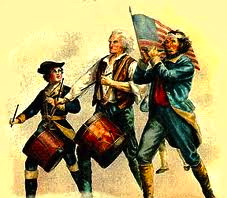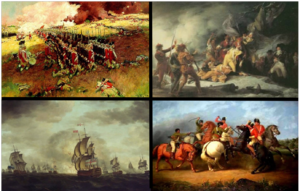American Revolutionary War


In 1763, the capitol city of America is London, George Washington is lobbying for a post in the British army, and no one thinks of Boston harbor when they hear talk of tea parties. In a dozen years, the colonies are on the brink of rebellion. What happens to bring this country so quickly near war with England?
 The American Revolutionary War (1775–1783), the American War of Independence, or simply the Revolutionary War in America, began as a war between the Kingdom of Great Britain and the new United States of America, but gradually expanded to a global war between Britain on one side and the United States, France, Netherlands and Spain on the other. The main result was an American victory, with mixed results for the other powers.
The American Revolutionary War (1775–1783), the American War of Independence, or simply the Revolutionary War in America, began as a war between the Kingdom of Great Britain and the new United States of America, but gradually expanded to a global war between Britain on one side and the United States, France, Netherlands and Spain on the other. The main result was an American victory, with mixed results for the other powers.
The war was the result of the political American Revolution. Colonists galvanized around the position that the Stamp Act of 1765, imposed by Parliament of Great Britain, was unconstitutional. The British Parliament insisted it had the right to tax colonists. The colonists claimed that, as they were British subjects, taxation without representation was illegal. The American colonists formed a unifying Continental Congress and a shadow government in each colony, though at first remaining loyal to the king. The American boycott of taxed British tea led to the Boston Tea Party in 1773, when shiploads of tea were destroyed. London responded by ending self-government in Massachusetts and putting it under the control of the British army with General Thomas Gage as governor. In April 1775 Gage learned that weapons were being gathered in Concord, and he sent British troops to seize and destroy them. Local militia confronted the troops and exchanged fire (see Battles of Lexington and Concord). After repeated pleas to the British monarchy for intervention with Parliament, any chance of a compromise ended when the Congress were declared traitors by royal decree, and they responded by declaring the independence of a new sovereign nation, the United States of America, on July 4, 1776. American Loyalists rejected the Declaration, and sided with the king; they were excluded from power everywhere. American attempts to expand the rebellion into Quebec and the Floridas were unsuccessful.
Clockwise from top left: Battle of Bunker Hill, Death of Montgomery at Quebec, Battle of Cowpens, “Moonlight Battle”
France, Spain and the Dutch Republic all secretly provided supplies, ammunition and weapons to the revolutionaries starting early in 1776. By June 1776 the Americans were in full control of every state, but then the British Royal Navy captured New York City and made it their main base. The war became a standoff. The Royal Navy could occupy other coastal cities for brief periods, but the rebels controlled the countryside, where 90 percent of the population lived. British strategy relied on mobilizing Loyalist militia, and was never fully realized. A British invasion from Canada in 1777 ended in the capture of the British army at the Battles of Saratoga. That American victory persuaded France to enter the war openly in early 1778, balancing the two sides’ military strength. Spain and the Dutch Republic—French allies—also went to war with Britain over the next four years, threatening an invasion of Great Britain and severely testing British military strength with campaigns in Europe. Spain’s involvement resulted in the expulsion of British armies from West Florida, securing the American southern flank. The decisive British naval victory at the Battle of the Saintes thwarted French and Spanish plans to drive Britain out of the Caribbean, and the joint Franco-Spanish attempt to capture the British stronghold of Gibraltar also resulted in similar defeat.
French involvement proved decisive yet expensive, ruining France’s economy and driving the country into massive debt. A French naval victory in the Chesapeake led to a siege by combined French and Continental armies that forced a second British army to surrender at the Yorktown, Virginia in 1781. Fighting continued throughout 1782, while peace negotiations began.
In 1783, the Treaty of Paris ended the war and recognized the sovereignty of the United States over the territory bounded roughly by what is now Canada to the north, Florida to the south, and the Mississippi River to the west. A wider international peace was agreed, in which several territories were exchanged.


